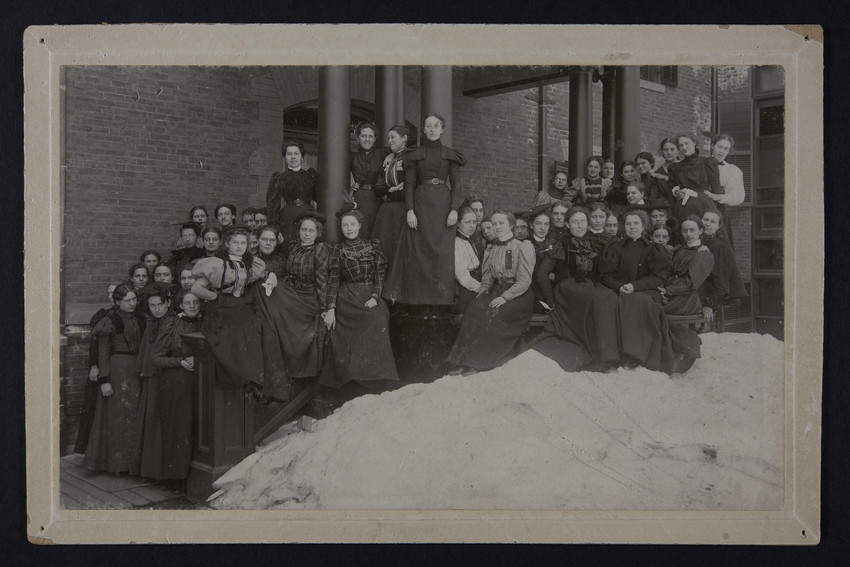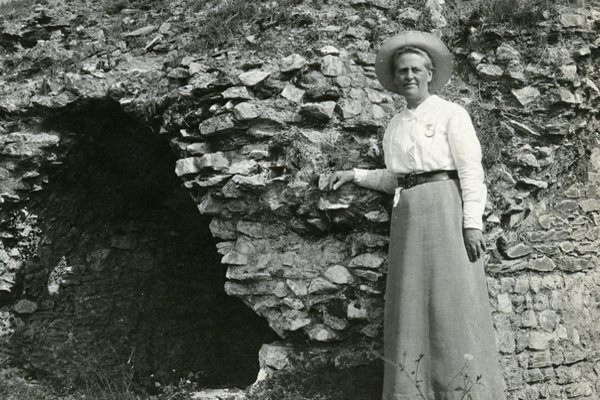When describing Italy’s first American woman archaeologist, the word ‘pioneer’ comes to the minds of many. Indeed, Esther Boise Van Deman is marked in history as a trailblazer. This can be attributed to her early lifestyle as a settler in America’s Old Northwest during the second half of the 19th century. Though she spent a mere three years at Mount Holyoke College, Van Deman’s work resonates at the school as a backbone for its classics and art history departments.
EARLY PIONEER
The beginning of her legacy could be found in South Salem, Ohio on October 1, 1862. Van Deman was born into a family with roots penetrated deep into the grounds of the foundation of the United States. Her own grandfather fought in the Revolutionary War which motivated her ancestral migration to the new western lands of the country. This area was rich with pioneer families who had similar backgrounds to Van Deman’s. The status quo of communities like the one she grew up in was to break out of the norms set by coastal societies. With the lack of single men willing to independently operate farms, a new desire for hard-working, powerful wives and large families arose. Historians praise the late 19th century rural America for being a place where children were raised to break away from gender and age hierarchies, shaping them to be “more self-reliant, mobile, adaptable, responsible, independent, and in touch with nature.”1 This upbringing could not better describe the reason behind Esther’s ambitious personality and successes.
UNCONVENTIONAL LEARNING
It was fairly uncommon during the 19th century for women to take up an interest in Latin and Classics because society deemed that these sects of academia were more well-suited for men. Of course Van Deman was not willing to submit to such ridiculous rules. She mobilized herself into the world of classical archaeology at the University of Michigan under the close mentorship of Professor Francis W. Kelsey, a world-renowned archaeologist who is celebrated for leading the first expedition to the Near-East. Their common independent and aspiring personalities are perhaps the reason Kelsey and Van Deman shared a bond that lasted a lifetime, opening many doors to her future.
THE NEW ENGLAND FRONTIERS
Moving to the northeast served as a new, changing phase in her life, as she was now surrounded by people who were shaped by the exact social constructions that she was taught to break free from. With the pressures of the educational elite in New England, Van Deman poured all of her frustrations onto her studies of the Vestal Virgins as she taught Latin at Wellesley and Bryn Mawr. She produced The Duties of the Vestals in 1895, the work that would initiate her reputation as a magnificent scholar of classical archaeology. This piece was presented at one of the first Midwestern Classics conferences in Ann Arbor held by none other than Francis W. Kelsey himself. It is without a doubt that Van Deman was an accomplished student in the eyes of her mentor, and even more so asserted when Kelsey describes her as “a woman of high ideals, of comprehensible grasp as well as faithfulness to detail.”2
At the turn of the century, liberal arts institutions were seeking out more qualified staff in order to improve their prestige and Van Deman was not looking to fall behind in her work field. During the last two years as a professor at this time, she sought out recommendations from the Presidents of Bryn Mawr and Wellesley for her applications to Ph.D. programs but found it quite challenging. Working under the instruction of other women, especially New England women, was something Van Deman ultimately loathed3 4 and it is most probably due to the fact that these New England women were mostly raised on the Protestant teachings of being quiet, polite, reserved and submissive to men. It had to be so irritating for a woman who had been taught all her life to be bold and empowering to be surrounded by women whom she would never be able to take seriously.

Nevertheless, Van Deman received her Ph.D. from the University of Chicago and went straight on to teach Latin at Mount Holyoke College from 1898 to 1901. Though largely commended for being an excellent teaching skills, her discomfort was known and criticized by her peers at the women’s college. Another University of Michigan alumna who taught Greek at Mount Holyoke during the same time Van Deman did, Mary Gilmore Williams, wrote in a letter to Kelsey:
Her teaching has been eminently successful, but it seems to me that she will never enjoy work in a college for women nor in fact any where that ‘residence’ is required unless it should be in Utopia where people have no nerves and no feelings.. She has very unusual executive ability and a restless energy which forces her to plan continually for other people and in a position where she had entire charge of her department she would be much more likely to enjoy her work.5
Williams may have ignited the path that led Van Deman to make her way to the American School of Classical Studies in Rome. Being a former student herself a few years back, she knew that Van Deman’s bright future was a voyage away across the Atlantic Ocean and with Kelsey’s position as the Annual Professor of the School, it was more than certain that support would be guaranteed. However, Van Deman was still hesitant and anxious before submitting her application because of the brutal sexism still present within the School. Women weren’t allowed to attend certain lectures6 and required to live in a separate building from campus. She might’ve not done too well on a personal level with women as her superiors, but she was not going to excuse the ill-treatment of any woman who was eager to learn and work hard. Kelsey must have assured Van Deman that such belligerence would not be met during her stay, because she successfully applied shortly thereafter.
SETTLING IN ROME
The American School of Classical Studies in Rome (now known as the American Academy in Rome) received Esther Van Deman as a student in the fall of 1901. Little did anyone know, she would eventually become a key figure to the institution and a scholastic significance to classical archaeology as soon as she set foot onto this new world.
Van Deman thrived from the very beginning of her time at the Academy. She was continuously commended in the director’s report for her work, developing connections with important people such as Thomas

Ashby: director of the British School at Rome, and contributing heavily to her photography series which now serves as a highly-valued collection. After her three years in Rome, Van Deman taught at Goucher College for a brief period until she won a fellowship from the Carnegie Institution which guaranteed her prolonged stay back at the Academy. With the grant of this fellowship she began establishing herself in the field of archaeology. It is in the Academy that her famous handbook on Roman construction techniques, a work that would only be completed past her lifetime, would begin to formulate. Though she was the first woman to lead the Academy’s field trips, Van Deman was praised even more so for her compelling lectures and organizational skills. Teaching to those who were eager to learn became a passion of hers. Publications on the Vestal inscriptions, statues and monograph Atrium Vestae were boosting her reputation as an exceeding scholar in archaeology.
As if Van Deman’s presence in Italy wasn’t enough, she also maintained close ties with her homeland. If she wasn’t helping her good friend and former colleague, Louise Fitz-Randolph, buy plaster casts for Mount Holyoke College’s collection, she was giving lectures at different colleges about Roman construction7. At one of these lectures, Van Deman met Mount Holyoke student Marion Blake and began to kindle a mentorship. Marion Blake herself came from a modest upbringing in the northeastern United States which appealed to Van Deman’s own values made great reasoning as to why she took her under her wing. Once the grand United States tour ended, she went back to work on her handbook and travel around the Mediterranean to visit and participate in excavations, including a solo trip to North Africa for two months in the spring of 1913.
THE WAR ON HEALTH
World War I left Italy with little to no economic stability and harsh living conditions. Van Deman did not handle these pressures well to say the least, she had to worry about sending her family money back to the United States for financial support. This war took an enormous toll on her mental health which required her to take a leave of absence from the Academy for five years and admit herself into a psychiatric ward for treatment back home. The progress of her handbook was delayed to such extremity due to this unfortunate period in her life. Even after her return to Italy in 1922, Van Deman remained suffering but she continued working regardless. Thomas Ashby collaborated with her on the studies of Roman Aqueducts while she began organizing notes for Marion Blake to abandon her own life’s work on Roman mosaics in order to complete the Roman construction handbook.
The last years of Esther Van Deman were neither glorious nor peaking in any way. It was a time of closure, to pass down the legacy she had to created onto a new generation of women archaeologists. Until her death in May 3, 1937, Van Deman worked with determination to ensure her work in archaeology would resonate and create deep significance for scholars. Though she struggled with frailty and illness, she successfully left an impact in classical archaeology and became a reference to the revolution of women archaeologists.
WORKS CITED
ASCMHC = South Hadley, Massachusetts, Archives and Special Collections, Mount Holyoke College
Esther Boise Van Deman Papers, RG 19.
Classical and Archaeological Club File, RG 25.
Marion Blake Papers, MS 0721 (LD 7092.8 Blake).
Pearsons Hall Records, RG 24.
Geffcken, Katherine. Esther B. Van Deman. Rome, Italy: American Academy in Rome Press, 1990.
Geffcken, Katherine, and Anne Laidlaw. “A Blessing and a Curse: Esther Van Deman and Marion E. Blake.” In Musiva E Sectilia, edited by Elizabeth Fentress, 73-83. Pisa/Roma, Italy: Fabrizio Serra Editore, 2010.
Letters of Correspondence between Louise Fitz-Randolph and Esther Van Deman. Plaster Casts Collection Folder. Mount Holyoke College Art Museum Archives. South Hadley, Massachusetts, 1907-1910.
Boundless. Boundless U.S. History. Pioneer Women. n.p., 2016. https://www.boundless.com/u-s-history/textbooks/boundless-u-s-history-textbook/the-gilded-age-1870-1900-20/the-transformation-of-the-west-149/pioneer-women-794-2429/.
Kelsey Museum Papers, Bentley Historical Library, University of Michigan.
Written by Renée Nicolaevski Portes, Class of 2018
- Boundless. Boundless U.S. History. Pioneer Women. ↵
- Kelsey Museum Archives. Kelsey Letters. March 7, 1896. ↵
- Kelsey Museum Archives. Kelsey Letters. March 1896. ↵
- Kelsey Museum Archives. Kelsey Letters. April 12, 1900. ↵
- Kelsey Museum Archives. Kelsey Letters. ca. 1900. ↵
- Kelsey Museum Archives. Kelsey Letters. February 20, 1901. ↵
- Mount Holyoke College Archives. MHC Classics and Archaeology Club File. January 7, 1911. ↵